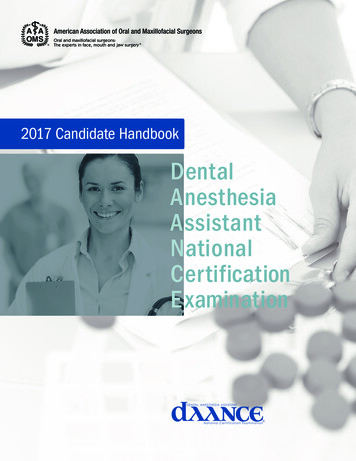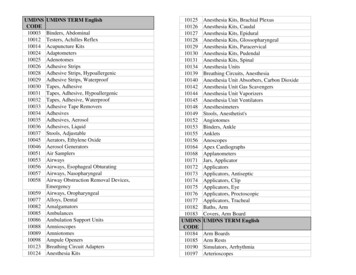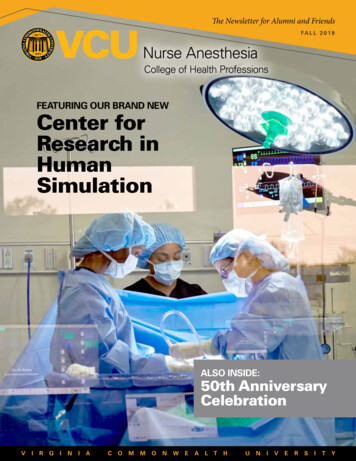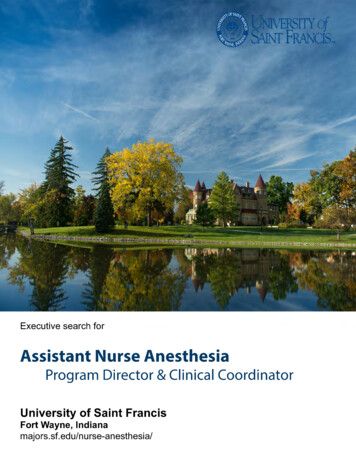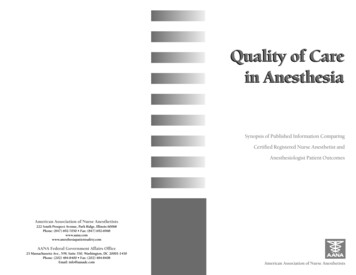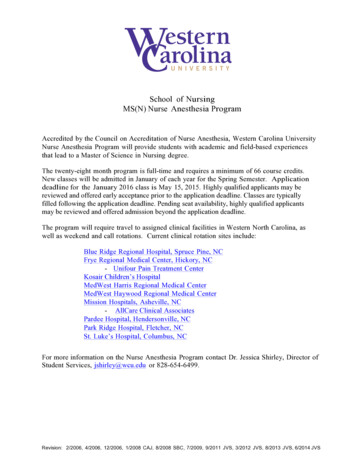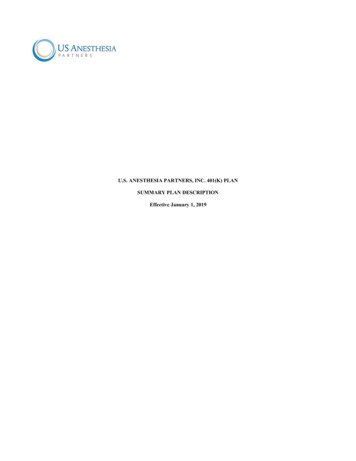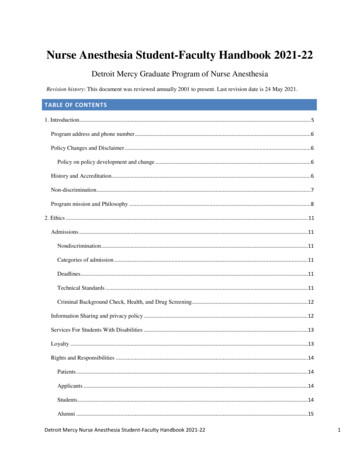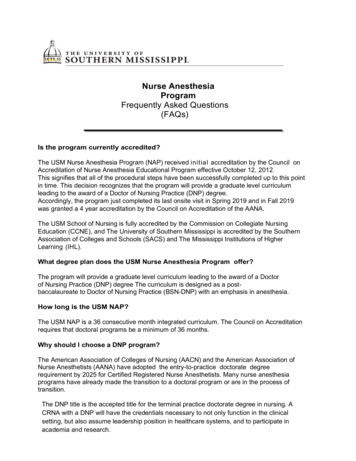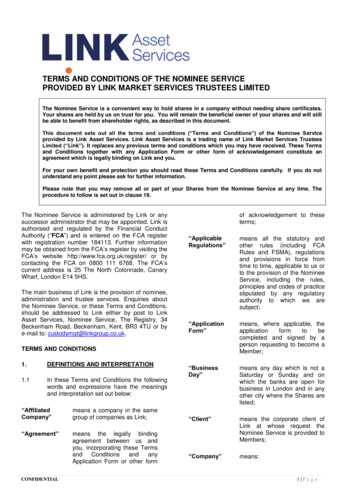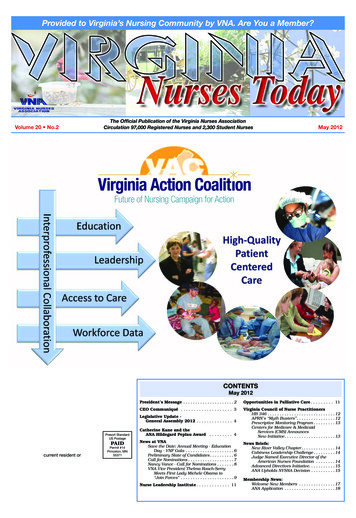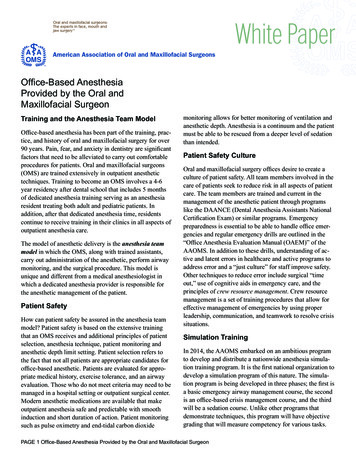
Transcription
American Association of Oral and Maxillofacial SurgeonsOffice-Based AnesthesiaProvided by the Oral andMaxillofacial SurgeonTraining and the Anesthesia Team ModelOffice-based anesthesia has been part of the training, practice, and history of oral and maxillofacial surgery for over90 years. Pain, fear, and anxiety in dentistry are significantfactors that need to be alleviated to carry out comfortableprocedures for patients. Oral and maxillofacial surgeons(OMS) are trained extensively in outpatient anesthetictechniques. Training to become an OMS involves a 4-6year residency after dental school that includes 5 monthsof dedicated anesthesia training serving as an anesthesiaresident treating both adult and pediatric patients. Inaddition, after that dedicated anesthesia time, residentscontinue to receive training in their clinics in all aspects ofoutpatient anesthesia care.The model of anesthetic delivery is the anesthesia teammodel in which the OMS, along with trained assistants,carry out administration of the anesthetic, perform airwaymonitoring, and the surgical procedure. This model isunique and different from a medical anesthesiologist inwhich a dedicated anesthesia provider is responsible forthe anesthetic management of the patient.Patient SafetyHow can patient safety be assured in the anesthesia teammodel? Patient safety is based on the extensive trainingthat an OMS receives and additional principles of patientselection, anesthesia technique, patient monitoring andanesthetic depth limit setting. Patient selection refers tothe fact that not all patients are appropriate candidates foroffice-based anesthetic. Patients are evaluated for appropriate medical history, exercise tolerance, and an airwayevaluation. Those who do not meet criteria may need to bemanaged in a hospital setting or outpatient surgical center.Modern anesthetic medications are available that makeoutpatient anesthesia safe and predictable with smoothinduction and short duration of action. Patient monitoringsuch as pulse oximetry and end-tidal carbon dioxidemonitoring allows for better monitoring of ventilation andanesthetic depth. Anesthesia is a continuum and the patientmust be able to be rescued from a deeper level of sedationthan intended.Patient Safety CultureOral and maxillofacial surgery offices desire to create aculture of patient safety. All team members involved in thecare of patients seek to reduce risk in all aspects of patientcare. The team members are trained and current in themanagement of the anesthetic patient through programslike the DAANCE (Dental Anesthesia Assistants NationalCertification Exam) or similar programs. Emergencypreparedness is essential to be able to handle office emergencies and regular emergency drills are outlined in the“Office Anesthesia Evaluation Manual (OAEM)” of theAAOMS. In addition to these drills, understanding of active and latent errors in healthcare and active programs toaddress error and a “just culture” for staff improve safety.Other techniques to reduce error include surgical “timeout,” use of cognitive aids in emergency care, and theprinciples of crew resource management. Crew resourcemanagement is a set of training procedures that allow foreffective management of emergencies by using properleadership, communication, and teamwork to resolve crisissituations.Simulation TrainingIn 2014, the AAOMS embarked on an ambitious programto develop and distribute a nationwide anesthesia simulation training program. It is the first national organization todevelop a simulation program of this nature. The simulation program is being developed in three phases; the first isa basic emergency airway management course, the secondis an office-based crisis management course, and the thirdwill be a sedation course. Unlike other programs thatdemonstrate techniques, this program will have objectivegrading that will measure competency for various tasks.PAGE 1 Office-Based Anesthesia Provided by the Oral and Maxillofacial Surgeon
White PaperThe first module is scheduled for completion and release inthe spring of 2017.HistorySince December 1844, when Dr. Horace Wells, a dentist,first demonstrated that volatile gases could be inhaled andused for medical and dental anesthesia, oral and maxillofacial surgeons have been the recognized leaders among thenation’s dental and medical professionals for the deliveryof safe and effective outpatient anesthesia. In addition, theAmerican Association of Oral and Maxillofacial Surgeons,continues to be consulted by other medical and dentalspecialties, accrediting agencies, and regulatory bodiesregarding standards and anesthetic safety.The history of oral and maxillofacial surgery office-basedanesthesia parallels the emergence of the medical hospitalmodel when, in the 1930’s, Dr. John Lundy, who firstdeveloped and used the IV pentothal technique at theMayo clinic, taught the new IV procedure to Mayo’s Chiefof Oral Surgery, Dr. Ed Staffney. Dr. Staffney, in turn,ensured that all oral surgery residents at the Mayo Clinicwere taught IV pentothal anesthesia as part of their clinicaltraining. The Mayo Clinic’s senior oral surgery resident atthat time was Adrian Hubble, who went on to teach thistechnique to oral surgeons across United States.Clearly, dental office-based anethesia is not new; in fact,it actually predates the development of certified registerednurse anesthetists. Dentistry, specifically oral and maxillofacial surgery, has remained in the forefront of the field ofanesthesia. Fearful patients, who are often in pain, are effectively, economically, and safely managed in the oral andmaxillofacial surgery office with the use of deep sedation/general anesthesia that frequently incorporate agents suchas propofol and/or ketamine. Prospective and retrospectivemorbidity and mortality studies of deep sedation/generalanesthesia in the oral and maxillofacial surgery officereveal an enviable safety record that compares favorablywith hospital based care.In April 1985, the National Institute of Dental Research(NIDR) of the National Institutes of Health (NIH), theFood and Drug Administration (FDA), and the NIH Officeof Medical Applications of Research (OMAR) sponsoreda National Institues of Health Consensus DevelopmentConference on “Anesthesia and Sedation in the DentalOffice.” Its consensus statement included:Pain is a major factor that brings patients to thedental office, while fear and anxiety about painare common reasons patients fail to seek dentalcare. The magnitude of the public-health problemis indicated by the fact that 35 million Americansavoid dental treatment until forced into the officewith a toothache. The control of pain and anxietyis therefore an essential part of dental practice. . .The use of sedative and anesthetic techniquesin the dental office represents a unique situationwhen compared with their use in the hospital environment. These differences often are not clearlyunderstood, and as a result, the use of sedationand anesthesia in the dental office has sometimesbeen unduly criticized . . .After listening to a series of presentationsby experts in the relevant basic and clinicalscience areas, a consensus panel composed ofindividuals knowledgeable in medical and dentalanesthesiology, oral and maxillofacial surgery,pediatric dentisty, pharmacology, behavioralscience, biostatistics, epidemiology, generaldental practice, dental educaiton, and publicinterest considered all the materal presented andagreed[on the following conclusion]: The useof all effective drugs carry some risk, howeversmall. Available evidence suggest that the useof sedative anesthetic drugs in the dental officeby appropriately trained professionals has aremarkable record of safety [Emphasis added].The consensus statement concluded the following regarding personnel:For conscious sedation, the practitioner responsible for treatment of the patient and/or the administration of drugs must be appropriately trained inthe use of such techniques. The minimum numberof people involved should be two, i.e., the dentistand an assistant trained to monitor appropriatephysiologic parameters. For deep sedation orgeneral anesthesia at least three individuals, eachappropriately trained, are required. One is the operating dentist, who directs the deep sedation orgeneral anesthesia. The second is a person whosePAGE 2 Office-Based Anesthesia Provided by the Oral and Maxillofacial Surgeon
White Paperresponsibilities are observation and monitoringof the patient . . . The third person assists theoperating dentist.The American Dental Association (ADA) Policy Statementon “The Use of Conscious Sedation, Deep Sedation andGeneral Anesthesia in Dentistry;” the 2012 AmericanAssociation of Oral and Maxillofacial Surgeons [AAOMS]“Parameters of Care for Anesthesia and Outpatient Facilities;” “The Accreditation Standards for Advanced Specialty Education Programs in Oral and Maxillofacial Surgery;”and the AAOMS’s “Office Anesthesia Evaluation Manual”are consistent with the conclusions of the NIH ConsensusDevelopment Conference. Further, AAOMS “Parametersof Care for Anesthesia and Outpatient Facilities” arereviewed and concurred with by the American Society ofAnesthesiologists.The President of the American Society of Anesthesiologists has written,Since members of the AAOMS [American Association of Oral and Maxillofacial Surgeons] havea long history of safely using general anesthesiain the care of their patients, it is the feeling of theAmerican Society of Anesthesiologists that thejoint ASA/AANA statement [regarding restrictions on the use of propofol by physicians with notraining in the performance of general anesthesia]is not intended for these AAOMS members.In order to maintain AAOMS membership, oral andmaxillofacial surgeons must complete AAOMS’s mandatory Office Anesthesia Evaluation (OAE) program everyfive years, and maintain malpractice insurance coverage.AAOMS members are eligible for malpractice insurancecoverage throughthe OMS National Insurance Company(OMSNIC).The Bylaws of the American Association of Oral andMaxillofacial Surgeons state:AAOMS fellow/members must have their officessuccessfully evaluated and re-evaluated bytheir component society every five years or inaccordance with the state law, provided that thestate law does not exceed six (6) years betweenevaluations and otherwise meets AAOMS officeanesthesia guildelines. State or componentsocieties will notifiy AAOMS immediately of anystate/component society fellow/member who doesnot fulfill this requirement.The AAOMS Office Anesthesia Evaluation program isnot mandated or suggested by any government or outsideagency. It was conceived, developed, implemented, andmandated by the AAOMS through its component statesocieties to benefit the public, whom its members serve.The AAOMS Office Anesthesia Evaluation programconsist of four parts:Part I.An evaluation of the office facilities, emergencymedications, and emergency equipment available;Part II.A demonstration by the oral and maxillofacialsurgeon and his/her team of the management ofsimulated office emergencies;Part III. A discussion between the evaluators and the oraland maxillofacial surgeon that involves a critiqueof the emergency demonstrations and/or facility;andPart IV. An observation of the anesthesia/surgeriesperformed in the office (subject to state laws andpatient consent)The AAOMS Office Anesthesia Evaluation processencompasses training and evaluation of office facilities;equipment and personnel; monitoring; complicationsand emergencies, including laryngospasm, syncope,venipuncture, bronchospasm, emesis and aspiration offoreign material, airway obstruction by foreign body,angina pectoris, myocardial infraction, and cardiac arrest;cardiopulmonary resuscitation (CPR); management ofblood pressure problems; drug allergies; hyperventilation;convulsions; malignant hyperthermia; and anesthesia forpatients suspected of substance abuse.As the surgical specialists of the dental profession, oraland maxillofacial surgeons are trained in all aspects ofanesthesia adminstration. OMS residents complete a rotation on the medical anesthesiology service, during whichthey train alongside anesthesiology residents under thesupervision of an anesthesiologist. Those who complete anoral and maxillofacial surgery residency training programare competent to administer safe and efficient anesthesiain the outpatient setting. With their training in both patientPAGE 3 Office-Based Anesthesia Provided by the Oral and Maxillofacial Surgeon
evaluation and emergency management, they are preparedto address any situation they may encounter. The ASA, theeducational, research, and scientific association of physiscian anesthesiologists, supports the ability of oral andmaxillofacial surgeons to saftely and compentently administer anesthesia in the office-based surgical setting. Quickonset and smooth induction, short duration and recoverytime, and few side effects make propofol a necessary agentin providing oral and maxillofacial surgery patients a safe,predictable and comforatable anesthetic experience.Medical and dental health insurance costs continue to riseand many patients do not have dental health insurancebenefits. As a result, when dental problems arise, theemergency room is the place where many of these patientsseek treatment. The cost for this treatment can be significant, especially if the patient must be admitted and treatedin the hospital operating room or intensive care. Oftenthese visits could be avoided by early intervention in thesafe and economically resonable environment of an oraland maxillofacial surgeon’s office utilizing the anesthesiatechniques employed on a daily basis.The oral and maxillofacial anesthesia team model is notonly safe, but also offers significant cost savings comparedto other forms of out-patient anesthesia. Office-based anesthesia services eliminate out-patient facility fees and feesgenerated by other medical professionals such as anesthesiologist or CRNAs. The anesthesia model used by oraland maxillofacial surgeons provide safe and cost-effectivetreatment that allows access to care for fearful patients andpermits trained professionals to deliver surgical servicesthat require deeper levels of anesthesia in the office. Wemust strive to never relinquish our leadership role inproviding safe and effective anesthetic care that is essentialto the health and well-being of our patients.References:Accreditation Standards for Advanced Specialty Education Programsin Oral and Maxillofacial Surgery. Chicago, IL: Commission on DentalAccreditation and American Dental Association; 2016, last revised2016.Alabama Board of Medical Examiners Administrative Code. Chapter540-X-10 Office Based Surgery. Available at: ocs/mexam/index.html. Accessed September 1, 2016.Anesthesia and Sedation in the Dental Office. NIH Consensus Statement. 1985 Apr 22-24;5:1-18. Available at: 050html.htm. Accessed September 1,2016.White PaperAnesthesia in Outpatient Facilities. Parameters of Care: ClinicalPractice Guidelines for Oral and Maxillofacial Surgery (AAOMSParCare 2012). 5th ed. Rosemont, IL: American Association of Oraland Maxillofacial Surgeons; 2012;e31-e49.ASOS anesthesia morbidity and mortality survey. J Oral Surg.1974;32:733-738.Coyle TT, Helfrick JF, Gonzalez ML, Andresen RV, Perrott DH.Office-based ambulatory anesthesia: factors that influence patientsatisfaction or dissatisfaction with deep sedation/general anesthesia. JOral Maxillofac Surg. 2005;63:163-172.D’Eramo EM, Bontempi WJ, Howard JB. Anesthesia morbidity andmortality experience among Massachusetts oral and maxillofacialsurgeons. J Oral Maxillofac Surg. 2008;66:2421-2433.Guidelines for the Use of Sedation and General Anesthesia by Dentists.Chicago, IL: American Dental Association; adopted 2012. Available at:http://www.ada.org/ /media/ADA/About%20the%20ADA/Files/anesthesia use guidelines.pdf?la en. Accessed September 1, 2016.Lee JS, Gonzalez ML, Chuang SK, Perrott DH. Comparison ofmethohexital and propofol use in ambulatory procedures in oral andmaxillofacial surgery. J Oral Maxillofac Surg. 2008;66:1996-2003.Letter from Anthony J. Guglielmi, Director of Corporate Communications, Somnia, Inc., regarding OMS safe use of propofol. Dated August22, 2005.Letter from H. N. White, Senior Medical Information Coordinator, Zeneca Pharmaceuticals Group, regarding the safe use of propofol. DatedJanuary 27, 1995.Letter from Roger W. Litwiller, President of the American Society ofAnesthesiologists, regarding the use of propofol and “the long historyof [members of the American Association of Oral and MaxillofacialSurgeons] safely using general anesthesia in the care of their patients.”Dated September 7, 2004.Lunn JN, Mushin WW. Mortality associated with anaesthesia. Anaesthesia. 1982;37:856.Lytle JJ, Yoon C. 1978 anesthesia morbidity and mortality survey:Southern California Society of Oral and Maxillofacial Surgeons. J OralSurg. 1980;38:814-819.Lytle JJ. Anesthesia morbidity and mortality survey of the SouthernCalifornia Society of Oral Surgeons. J Oral Surg. 1974;32:739-744.Massachusetts Board of Registration in Dentistry. 234 CMR 3.00 Administration of General Anesthetic, Deep Sedation, Conscious Sedation,and Nitrous Oxide-Oxygen Sedation, April 22, 2005. Available 03.pdf. AccessedSeptember 1, 2016.PAGE 4 Office-Based Anesthesia Provided by the Oral and Maxillofacial Surgeon
Memo from Department of Physician Services, The University ofTennessee Medical Center at Knoxville, stating anesthesiologists andoral and maxillofacial surgeons are exempt from anesthesia testing bynature of their training. Dated January 2008.Office Anesthesia Evaluation Manual. 8th ed. Rosemont, IL: AmericanAssociation of Oral and Maxillofacial Surgeons; 2012.Office-Based Surgery Guidelines. Waltham, MA: Massachusetts MedicalSociety; 2011. Available at tory/Office-Based-Surgery-Guidelines-(pdf)/. AccessedSeptember 1, 2016.Patient Assessment. Parameters of Care: Clinical Practice Guidelinesfor Oral and Maxillofacial Surgery (AAOMS ParCare 2012). 5thed. Rosemont, IL: American Association of Oral and MaxillofacialSurgeons; 2012;e12-e30.Perrott DH, Yuen JP, Andresen RV, Dodson TB. Office-based ambulatory anesthesia: outcomes of clinical practice of oral and maxillofacialsurgeons. J Oral Maxillofac Surg. 2003;61:983-995.Policy Statement: The Use of Sedationand General Anesthesia byDentists. Chicago, IL: American Dental Association; adopted 2012.Available at: http://www.ada.org/ /media/ADA/About%20the%20ADA/Files/anesthesia policy statement.pdf?la en Accessed September 1,2016.Rules of Tennessee Board of Dentistry. Chapter 0460-2 Rules Governingthe Practice of Dentistry. June 2015 (revised). Available at: http://share.tn.gov/sos/rules filings/03-17-15.pdf. Accessed September 1, 2016.Seldin HM, Recant BS. The safety of anesthesia in the dental office. JOral Surg (Chic). 1955;13:199-208.Seldin HM. Use of nitrous oxide-oxygen anesthesia in dental surgery.Cur Res Anesth Analg. 1947;26:248-254.South Carolina. Department of Labor, Licensing and Regulations. StateBoard of Medical Examiners. Chapter 81-96 Office Based Surgery [SCADC 81-96]. Available at : http://www.scstatehouse.gov/coderegs/Ch%2081.pdf. Accessed September 1, 2016.Tennessee. Board of Medical Examiners. Policy: Dual-Licensed Medical Doctors and Dentists Performing Office Based Surgery. AdoptedMarch 18, 2008. Available at: BME PolDualLicensedMDS.pdf. Accessed September 1,2016. 2016 American Association of Oral and Maxillofacial Surgeons.No portion of this publication may be used or reproduced withoutthe express written consent of the American Association of Oral andMaxillofacial Surgeons.PAGE 5 Office-Based Anesthesia Provided by the
joint ASA/AANA statement [regarding restric- . (OAE) program every five years, and maintain malpractice insurance coverage. AAOMS members are eligible for malpractice insurance coverage throughthe OMS National Insurance Company .
